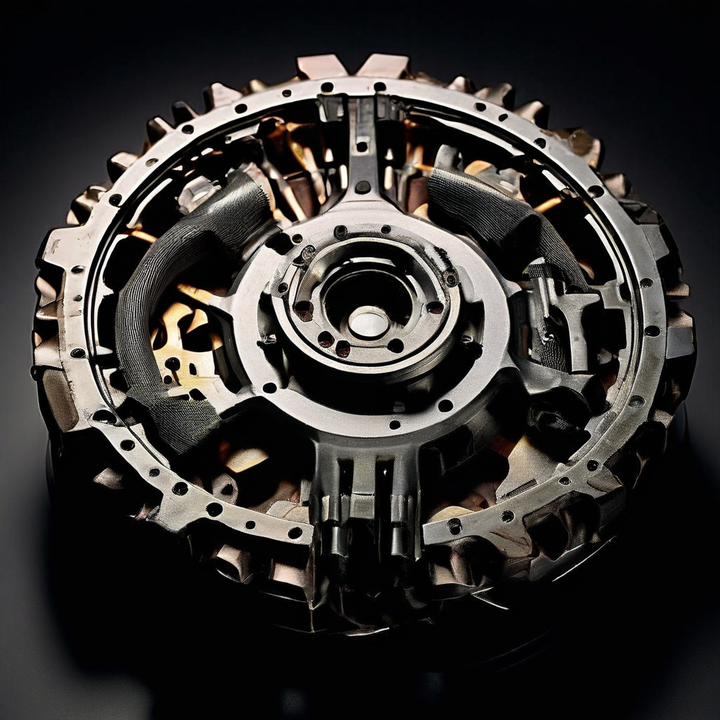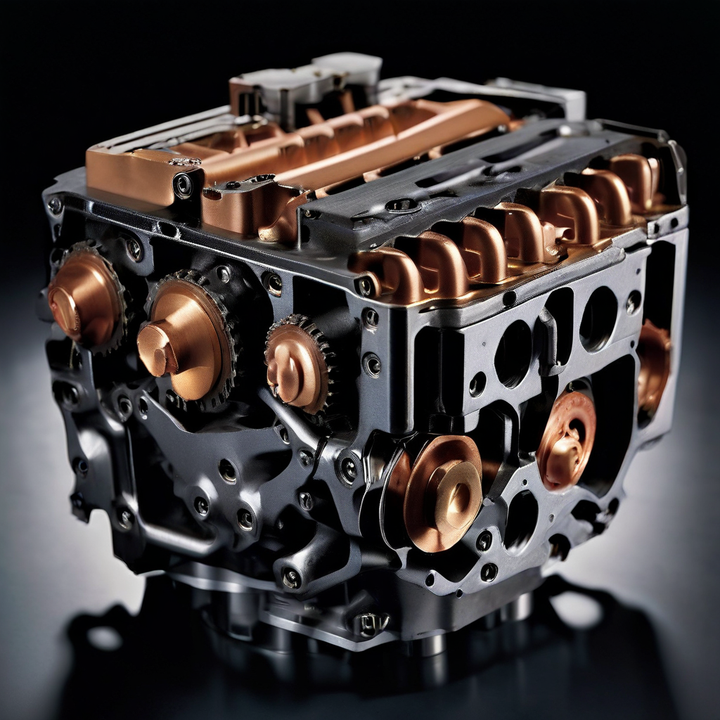


The cylinder head is an intricate and indispensable component that sits atop the engine block, orchestrating the intricate dance of combustion that propels your vehicle forward. This article delves into the intricacies of this vital engine part, exploring its definition, purpose, components, types, materials, functions, common issues, maintenance requirements, and the latest advancements in cylinder head technology.

The cylinder head is a meticulously engineered metal casting that seals the top of the engine cylinders, forming the combustion chamber where the air-fuel mixture ignites and burns. Its primary function is to regulate the precise flow of air, fuel, and exhaust gases in and out of the cylinders, while also providing a secure mounting point for crucial components such as valves, spark plugs, and fuel injectors.
| Component | Purpose |
|---|---|
| Combustion Chamber | The space where the air-fuel mixture is compressed and ignited, generating the power that drives the engine. |
| Intake and Exhaust Valves | Control the flow of the air-fuel mixture into the combustion chamber and the exhaust gases out of it, respectively. |
| Intake and Exhaust Ports | Allow the air-fuel mixture to enter the combustion chamber and the exhaust gases to exit. |
| Spark Plugs/Fuel Injectors | Provide the ignition source or fuel injection for the combustion process. |
| Valve Guides and Seats | Support and seal the valves, ensuring proper operation and preventing leaks. |
| Cooling Passages | Allow coolant to circulate and dissipate heat from the combustion process. |
The cylinder head is bolted to the top of the engine block, with a head gasket in between to ensure a tight seal. It works in tandem with the pistons, crankshaft, and other components to convert the energy from the combustion process into mechanical power that propels the vehicle.
A typical cylinder head is a symphony of intricate components that work together to facilitate the engine's operation.
The combustion chamber is the heart of the cylinder head, where the air-fuel mixture is compressed and ignited, generating the power that drives the engine. Its design and geometry play a crucial role in optimizing the combustion process and maximizing engine efficiency.
The intake and exhaust valves are the gatekeepers that control the flow of the air-fuel mixture into the combustion chamber and the exhaust gases out of it, respectively. These valves are operated by the camshaft(s) through a valve train mechanism, ensuring precise timing and coordination with the engine's cycle.
The intake and exhaust ports are the pathways that allow the air-fuel mixture to enter the combustion chamber and the exhaust gases to exit, respectively. The design and shape of these ports significantly impact the engine's airflow characteristics and, consequently, its performance and efficiency.
Spark plugs (in gasoline engines) and fuel injectors (in diesel engines) are mounted in the cylinder head and play a crucial role in the combustion process. Spark plugs provide the ignition source for the air-fuel mixture, while fuel injectors precisely deliver the fuel into the combustion chamber.
Valve guides and seats are the unsung heroes within the cylinder head that support and seal the valves, ensuring proper operation and preventing leaks. These parts are subject to wear over time and may require periodic maintenance or replacement.
The cylinder head features an intricate network of cooling passages that allow coolant to circulate and dissipate heat from the combustion process. Proper cooling is essential to prevent overheating and potential engine damage.
Cylinder heads can be classified based on their design and the arrangement of their components, each offering unique advantages and trade-offs.
| Design Type | Description |
|---|---|
| Flathead | An older configuration where the valves are located in the engine block, rather than the cylinder head. Simple construction but poor performance. |
| Overhead Valve (OHV) | Also known as the "I-head" design, the valves are located in the cylinder head, above the combustion chamber. Improved airflow and performance. |
| Overhead Cam (OHC) | The camshaft(s) are located within the cylinder head, directly actuating the valves without the need for pushrods. Further enhanced airflow and efficiency. |
Cylinder heads are typically manufactured using either cast iron or aluminum alloy, each material offering distinct advantages and trade-offs.

Cast Iron:
Durable and cost-effective
Excellent wear resistance
Can withstand high temperatures and pressures
Heavier and lower heat dissipation capabilities
Aluminum Alloy:
Lighter in weight
Superior heat dissipation properties
Improved engine cooling and potentially higher performance
More expensive and susceptible to warpage at extreme temperatures
The choice of material for the cylinder head depends on various factors, including engine design, performance requirements, cost considerations, and the intended application.
Beyond housing the valves and combustion chamber, the cylinder head serves several critical functions that directly impact the engine's overall performance and efficiency.
One of the primary functions of the cylinder head is to seal the combustion chamber, in conjunction with the head gasket. This seal is crucial for maintaining the high pressures and temperatures required for efficient combustion, preventing leaks and ensuring optimal engine operation.
The intricate network of cooling passages within the cylinder head plays a vital role in dissipating heat generated during the combustion process. Proper heat dissipation is essential to prevent overheating, which can lead to engine damage and reduced performance.
The design of the intake and exhaust ports, as well as the valve arrangement, significantly impacts the engine's airflow characteristics. Optimized airflow is crucial for maximizing power output, fuel efficiency, and minimizing emissions.
The cylinder head provides the mounting points for fuel injectors (in diesel engines) and spark plugs (in gasoline engines), which are essential components for the combustion process. Proper placement and integration of these components are critical for efficient and reliable engine operation.
The cylinder head's design and construction play a crucial role in determining an engine's power output, fuel efficiency, emissions, and overall performance. Manufacturers invest significant resources in optimizing cylinder head designs to meet specific performance and efficiency targets for their engines.
Like any engine component, cylinder heads can experience various issues over time, which can impact engine performance and potentially lead to costly repairs if left unaddressed.
| Issue | Description |
|---|---|
| Cracks | Caused by excessive heat, coolant leaks, or manufacturing defects. Can lead to compression loss, coolant leaks, and potential engine failure. |
| Warpage | Aluminum cylinder heads are susceptible to warpage due to extreme temperatures. Can cause head gasket failure, compression loss, and potential engine damage. |
| Valve and Seat Wear | Over time, the valves and their seats can wear down, leading to poor sealing, compression loss, and potential engine damage. |
Regular maintenance is crucial for ensuring the longevity and optimal performance of the cylinder head. This may include tasks such as:
Replacing the head gasket
Resurfacing the cylinder head to restore flatness
Inspecting and replacing worn valves and seats
Checking and adjusting valve lash (clearance)
In severe cases, a complete cylinder head replacement may be necessary to address significant damage or wear.
As engine technology continues to evolve, cylinder head designs are also advancing to meet stricter emissions regulations and performance demands.
Lightweight Materials:
Advanced aluminum alloys and composite materials
Further reduce weight and improve heat dissipation capabilities
Contribute to better fuel efficiency and performance
Variable Valve Timing:
Adjust the timing of the intake and exhaust valves dynamically
Optimize performance and efficiency across different operating conditions
Increasingly prevalent in modern engines
Integrated Exhaust Manifolds:
Cylinder head designs with integrated exhaust manifolds
Improve exhaust flow and reduce weight
Eliminate the need for separate manifold components
Additive Manufacturing:
3D printing and additive manufacturing techniques
Produce complex cylinder head designs with optimized internal geometries
Difficult or impossible to achieve through traditional manufacturing methods
As the automotive industry continues to push for higher efficiency, lower emissions, and better performance, the cylinder head will remain a critical area of research and development, driving innovation in engine technology.
The cylinder head is a vital component of an internal combustion engine, playing a crucial role in controlling the flow of air, fuel, and exhaust gases, as well as housing essential components like valves and spark plugs. Its design and construction significantly impact an engine's performance, efficiency, and durability, making it a key area of focus for automotive manufacturers and engineers. From material selection and component arrangement to advanced manufacturing techniques and variable valve timing systems, the cylinder head continues to evolve, enabling the development of more powerful, efficient, and environmentally friendly engines.
The cylinder head seals the top of the engine cylinders and houses crucial components like valves, spark plugs, and fuel injectors. It regulates the flow of air, fuel, and exhaust gases in and out of the cylinders.
The main components include the combustion chamber, intake and exhaust valves, intake and exhaust ports, spark plugs/fuel injectors, valve guides and seats, and cooling passages.
The main types are flathead, overhead valve (OHV), and overhead camshaft (OHC) designs, each offering different performance and efficiency characteristics.
Cylinder heads are typically made from cast iron or aluminum alloys, with aluminum offering better heat dissipation and weight savings.
The cylinder head gasket seals the cylinder head to the engine block, preventing leaks of coolant, oil, and combustion gases.
The cylinder head contains cooling passages that allow coolant to circulate and dissipate heat generated during the combustion process.
Common issues include cracks due to overheating, warpage, valve and seat wear, and coolant or oil leaks.
Regular maintenance helps identify and address issues like cracks, leaks, or worn components, preventing further damage and ensuring optimal engine performance.
Diesel engine cylinder heads often accommodate prechambers or swirl chambers for combustion, resulting in higher thermal stresses and more complex cooling designs.
Recent advancements include lightweight materials, variable valve timing systems, integrated exhaust manifolds, and additive manufacturing techniques for optimized designs.

Sarah isn't your average gearhead. With a double major in Mechanical Engineering and Automotive Technology, she dived straight into the world of car repair. After 15 years of turning wrenches at dealerships and independent shops, Sarah joined MICDOT to share her expertise and passion for making cars run like new. Her in-depth knowledge and knack for explaining complex issues in simple terms make her a valuable asset to our team.











